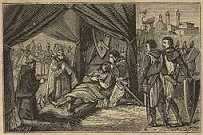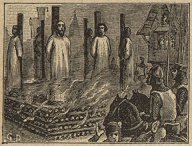
Gaulois Soldier
|
Some discoveries in Troyes and the neighbourhoods
testify to a significant occupation as early as in the prehistorical times. It is only
with the first Celtic migrations that a more stable population settled on the site of
Troyes ; the Tricasses. This local tribe, from which the name Troyes comes from, is
mentioned in the writings of the Greek geographers of the 2nd century BC. Excavations
highlighted the existence of habitation on the site of Saint-Nizier, and funerary objects
were found in the locality of "la Charme", which can be seen in St Loup's
museum. |
| In the 1st century BC, the Celtic city of Tricasses
became Augustobona, a Gallo-Roman city named after the Roman emperor Auguste. It occupied
a strategic situation; at the meeting point of several Roman ways, among which the Agrippa
way which connects Milan to Boulogne. Remains of this time are kept at the St Loup's
museum, and also exposed in the middle of recent constructions on the quay de abattoirs.
Very quickly, Augustobona extended and was strengthened, with the construction of Ramparts
and gates. |

Gaulois village
|

Franc Soldier
|
In the 3rd century AD, during the start of the
barbarian invasions, the city was renamed Tricassium, and then in 5th century Trecae. At
that time, Troyes seems to have been quite prosperous, if one believes the treasure found
on the Chaillouet site; an oil amphora which contained 102kg of coins. Fires devastated
the city in the 4th century during the Germanic invasions. Evangelisation brought its
first Bishop to Troyes, and it is Bishop Saint-Loup who in 451 saved the city from the
invasion of Attila, by giving himself as a hostage to the great warrior. He returned to
Troyes, died in 479 and was buried on the site of St Martin Es Aires. |

Attila and his troups

Clovis being baptised
|
With the death of Clovis, in 511, the Kingdom of
Francs was shared and Troyes was part of the Austrasie territory, directed by Thierry I,
Clovis's son. One has to wait till the end of the 6th century for the reconciliation
between the three great sons of Clovis, who reunited for the occasion near the tomb of
Bishop Saint Loup, in Troyes. In 581, Gallomagne, Bishop of Troyes, brought back the
relics of Saint Nizier from Lyon, to the small St Maur's church, later replaced by Saint
Nizier's church. Many religious buildings in Troyes appeared during the 7th century; the
Abbeys of Montier la Celle, Notre Dame aux Nonnains, Saint Quentin, and St Jean's and St
Denis's churches. |

Charlemagne
|
After the short existence of a Champagne duchy of
which Troyes, Reims and Chalons were part, the city was included in the new Kingdom of
France, ruled by Charlemagne. Its Bishop Alcuin undertook to reform the rules of the
religious life. In the middle of 9th century, France was again split, and Troyes ended up
in the part ruled by Charles Le Chauve (the bald). In 878, King Louis Le Bègue (the
Stammerer) was crowned in Troyes, in St Jean's church. The city was then devastated by
Norman invasions towards 890, and in spite of that, continued its expansion; the first
cathedral was erected, St Nicolas's hospital was founded in the vicinity, and buildings
emerged outside the City walls. It was at that time that the first commercial activities
developed. |

Lords' Wars

A Lord in arms
|
The city belonged to the Duchy of Burgundy at the
beginning of 10th century, and it was in 956 the first Count of Champagne, Robert,
"the very glorious Count of Champagne" ruled over the City. He was replaced by
Eudes "Le Grand" and Thibault Ist, who ruled the area during 52 years. The
Counts allowed the expansion of the city and particularly the Champagne fairs, which would
have attracted merchants from all over Europe. At that time, Saint Nizier's church was
built, the suburbs extended to the north-east from the ramparts, which were increased
(construction of the Holy Spirit gate/later Croncels). It was under Count Hugues "the
father of the poor" that Hugues de Payns created the Order of the Knights of the
Templars in 1118. |

A Belfry
|
Count Henri Ist "Le Liberal" succeeded his
father Thibaut II "Le Grand", and became son-in-law of King Louis VII by
marrying his daughter Marie de France. The first council of Troyes was created, managed by
"bourgeois" and a mayor (towards 1190). Major construction work was undertaken;
enlarging of the ramparts, creation of new canals and the construction of a new Palace for
the Counts, on the current Place du Préau. The churches of Sainte Madeleine, Saint
Nicolas and Saint Pantaléon were built at that time. New gates welcomed the European
merchants; St Jacques and the Beffroy's gate in particular. The Count and the Countess
favored a new artistic trend, with Chrestien de Troyes and other scholars, artists and
theologists being received in their Court. With the death of Henri Ist, Marie became
Regent of the County for 13 years, until her death in 1198. |

Saint Louis
|
Countess Blanche, wife of Henri's son Thibaut III who
died in 1201, took the regency until her son Thibaut IV came of age, in 1222. This Count,
a poet, a singer and a musician, finished building the ramparts which gave to Troyes its
final shape of a champagne cork and protected the city against the enemies that his
political errors attracted. It was at that time that the cathedral started to be rebuilt,
after the fire of 1188. Reforms modified both the management of the city, which was
partially delegated to thirteen "jurors", and the taxes, which became less
arbitrary. |

Death of Saint Louis near Tunis

Soldier under Philippe le Bel
|
After the short reigns of Thibaut V, who died in a
crusade, and of Henri III his brother, it was again a Countess who managed the County,
Blanche of Artois. It was by the marriage of her daughter Jeanne with the future King
Philippe le Bel (The beautiful) that Champagne finally became part of the Kingdom of
France. The first four decades of the XIVth century saw no less than five Kings following
one another upon the throne of France, and privileges held by the citizens of Troyes,
granted at the time of the Counts, were gradually reduced, for the city to completely
integrate into the Kingdom. |

Persecutions against templars under
Philippe Le Bel

Archers
|
At the beginning of the Hundred Year's war, the city
strengthened its ramparts, and prepared to receive the English invaders. New taxes
appeared in order to arm the city. In 1359, the army of Troyes liberated Aix-en-Othe,
Beaufort and Pont Sur Seine from the English army, led by a young Bishop-soldier, Henri de
Poitiers. The city finished the century very impoverished by the war expenditure; riots
even flared up in 1381 against the Bourgeois. |
On top of the Franco-English hostilities a new fight arose;
bringing Jean Sans Peur (without fear), Duke of Burgundy, against King Charles VI "le
Fol" (mad) who soon had to concede his crown and palace. King Henri V of England
seized the opportunity, that those internal quarrels produced, to advance his army. In
1420, the treaty of Troyes was signed, sworn upon by Charles VI and Henri V, in Troyes
cathedral. The treaty designated Henri V as the legitimate heir to the crown of France, at
the expense of the 'Dauphin', Charles VII.

Joan of Arc in action
|
In spite of everything he declared himself King of
France in 1522 and was joined by Joan of Arc on 23 February 1429. In July 1429, their
troops reached the ramparts of Troyes; Joan held up her flag and directed the preparations
for the assault, under the frightened eyes of citizens. The city eventually opened its
gates before the battle; Joan and Charles VII entered Troyes on July 10, and heard the
mass at the cathedral. |

Louis XI
|
The hostilities with the Burgundians placed the city
in a state of war until the treaty of Arras in 1435. At this time Troyes resumed its
commercial activities, strengthened by new privileges and rights granted by King Charles
VII, in gratitude for the peaceful surrender of the city. During the reign of Louis XI
from 1461, these privileges were soon cancelled and the royal control on the city was
reinforced until 1483, year of the King's death. This same year, Jean de Marisy became the
first mayor of the city. |

King François 1st made a Knight by Bayard
|
The peaceful first years of the century enabled Troyes
to recover its past prosperity; trade and craft industry developed (textile, tannery,
paper mill), the fortifications were renovated. There were now three doctors to look after
the growing population, which placed the city fifth in the Kingdom under the reign of
François Ist. The number of fairs also increased, those in January and August were added
in 1510 and the May and October ones in 1521. Arts were not forgotten in this renaissance
of the city, and it was the great period for the Troyes' school of sculpture. |
On 24 May 1524, a gigantic fire destroyed 1,500 dwellings in the
district of Beffroy and Croncels. Very quickly, the devastated areas were rebuilt, and it
was an opportunity for the town to adopt a more modern approach to town planning with
straighter and wider streets. |
![]()